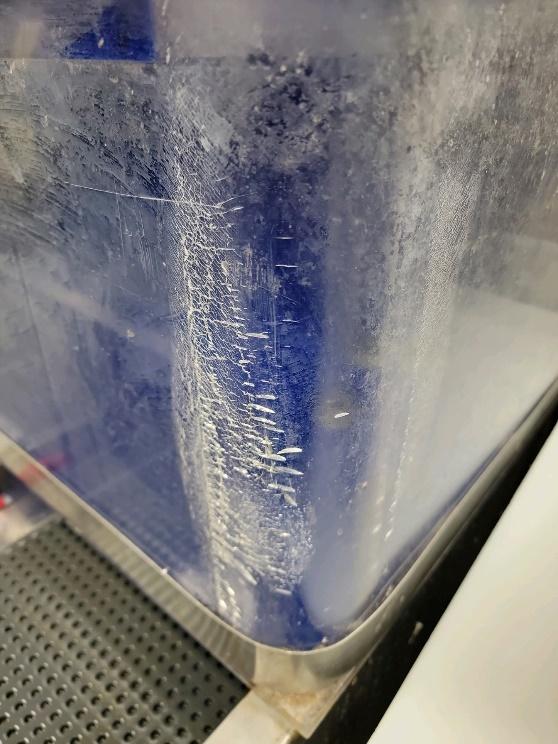Does your tank look like this?

Stress crazing, which appears as an area of tiny micro-cracks, occasionally shows up in areas on the surface of most thermoplastic sheets. This phenomena, although rare and preventable, is known to occur in many types of plastic sheet materials and occasionally shows up on the surface of acrylic aquariums, hot tubs, sneeze guards and many other products made of molded plastics.
There are numerous articles online specific to many materials and processes. In this article we will focus on aquariums, specifically in retail environments. Lobster tanks, shellfish tanks and the like are commonly made out of polymethyl methacrylate (PMMA), more popularly known as acrylic which is a transparent and rigid thermoplastic (soft when heated, hard when cooled).
Crazing is caused by exposing the acrylic to harsh chemicals such as ammonia-based window cleaners, alcohol based anti-bacterial wipes, or acetone cleaners to name a few. Most of the commonly used cleaning agents in a retail store are harmful to acrylic surfaces, especially those that have been heat bent (corners of a tank), chemically bonded (seams of a tank), or cut (lids of a tank). Every tank should have a bright yellow warning sign across it saying “DO NOT USE CHEMICALS TO CLEAN” but for obvious reasons that’s not possible. We’ve even seen a case where a dept was being painted and the painter left a container of paint thinner near the tank. The fumes alone were strong enough to cause crazing. Training and communication are key. If you are reading this article, it behooves you to share this information with your co-workers, employees, management team, and maintenance crew.
Unfortunately, the process can’t be fixed. There are many potions and lotions on the market but if the crazing on your tank is visible, it’s too late. The damage is done. Depending on where the crazing is will determine the overall integrity of the tank and it’s ability to hold water. “Will my tank bust open and cause a flood?”. Frankly, maybe, but not likely. There have been incidents of large exhibition tanks breaking open and loosing thousands, if not hundreds of thousands, of gallons of water due to crazing at the seams (there’s some pretty fascinating scenes on YouTube). The mere pressure from the mass volume of water is cause for an explosion. Retail aquariums will see signs of leaking first before the threat of a seam busting open becomes real.
In the beginning of the article, you’ll notice I bolded and underlined “preventable”. Because it IS! This part always cracks me up (pun intended). For a small price of $20, we sell a cleaning agent specifically made for acrylic that will not cause crazing, dulling, or micro scratches. I’ve had people tell me “I’m not spending $20 blah, blah, blah for a bottle of this stuff.” One bottle, if used properly, will last a year, or can be used on all acrylic surfaces and displays. It’s a small price to pay compared to a replacement tank.
For more information, or to order, call our office (201) 398-0303.
